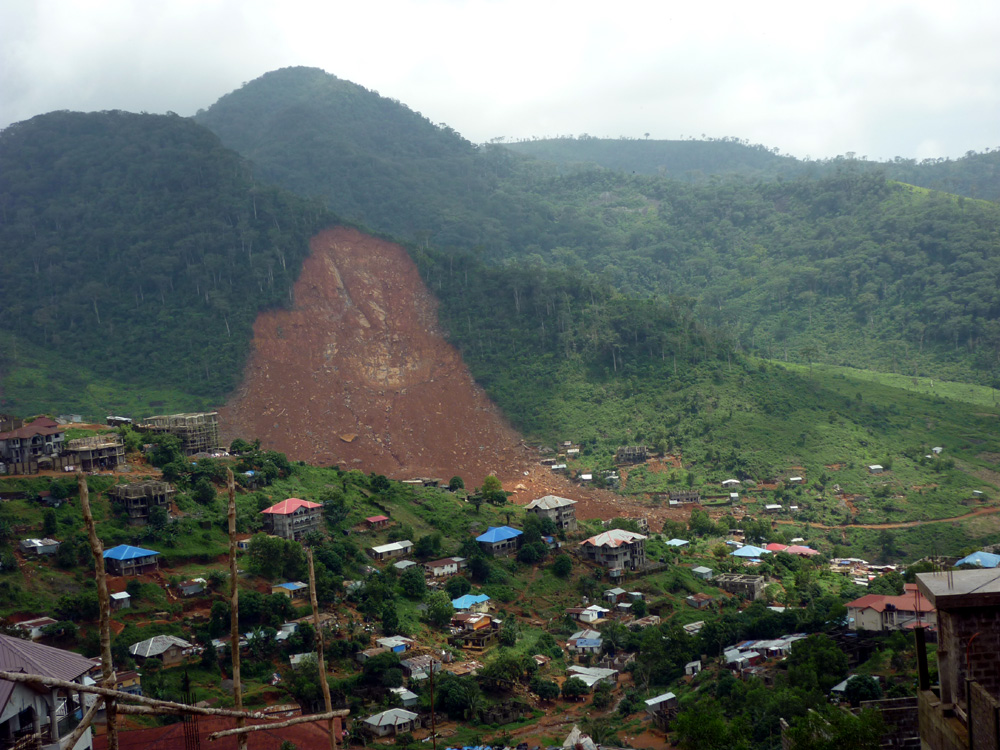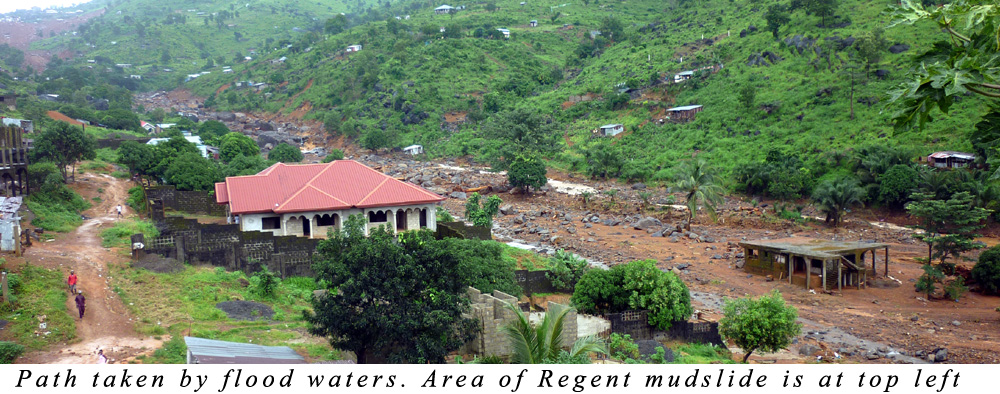Aug. 21, 2017
1000 feared dead in Sierra Leone
mudslide and flooding
 In the early hours of Monday,
August 14, heavy rains triggered flooding in Freetown and a
catastrophic landslide on one of the hills that tower above the city. A
torrent of mud and rock swept down from a section of Mount Sugar Loaf
onto a new community, Mothema, in the Regent mountain village. Most residents had
no chance of escape and were entombed underneath a mountain of debris
that submerged multi-storey houses. The grim task of recovery with
heavy machinery has thus far yielded only those bodies located at the
surface of the carnage.
In the early hours of Monday,
August 14, heavy rains triggered flooding in Freetown and a
catastrophic landslide on one of the hills that tower above the city. A
torrent of mud and rock swept down from a section of Mount Sugar Loaf
onto a new community, Mothema, in the Regent mountain village. Most residents had
no chance of escape and were entombed underneath a mountain of debris
that submerged multi-storey houses. The grim task of recovery with
heavy machinery has thus far yielded only those bodies located at the
surface of the carnage.Separately, downstream, an unknown number of residents were swept away to their death as flood waters rushed down towards the sea. Initial reports focused on the mudslide high up in the hills as the main destructive agent, with speculation that bodies discovered much further down the hills had somehow been carried there by the waters. Later, it became clear that a huge release of water had carved a path in places 150 ft wide and 20 ft high for miles through the Kamayama/Malama valley down to the Juba area. Huge boulders and uprooted trees remain as evidence of the destructive force of the waters, as they swept through residential communities built on the valley floor. Exactly where this water came from is the subject of much uncertainty. It had been raining heavily, but not extraordinarily so. The normal water course through the valley had often previously experienced heavier rains without anything close to this extent of water rise. Rumours of a dam failure in the mountains were denied. Some reports from the Regent landslide speak of an explosion of water hurling out huge boulders and a cloud of spray, leading to speculation that water stored under pressure within the mountain itself was released at the time of the mudslide, causing the flooding downstream. The scarred face of the mountain reveals no obvious cavity from which this water could have emerged. All eyewitness reports place the mudslide as occurring around 7a.m. whilst some residents down in the valley claim to have found themselves surrounded by water as early as 2 or 3a.m. Careful investigation is urgently needed to trace the exact nature, sequence and extent of the events.

Flooding in Freetown during the rainy season has been marked by its uncertainty. It appears impossible to predict when and where deadly torrents will appear. Following the last serious flooding, on September 16, 2015, many had thought the next major incident might occur in low-lying slum areas close to the city centre. Instead, in this incident, valleys to the west of the city were devastated, and serious flooding also occurred in a section of the east. The quantum of rainfall appears to not be the only factor in determining when flooding will occur. Similar amounts of rainfall as occurred in this latest incident have fallen on the city in the recent past without causing much damage. Indeed, although precise rainfall measurements are hard to come by, it would appear that Freetown has in recent years been spared the sustained, torrential downpours which have not been uncommon in past years.
We discussed the dangers of the situation after the 2015 floods, and we had also pointed out the dangers of the runoff from uncontrolled construction, including poorly planned road construction in earlier articles. The Regent area in particular, even more so than the rest of Freetown's mountain zone has experienced tremendous construction and population growth in recent years, and we see no evidence of a serious effort at runoff control. Allowing water to find its own course through the densely populated city is the height of irresponsibility. As a minimum first step to begin to bring the situation under control, we suggest the following:
- An immediate halt to all construction and land acquisition or
transfer above the height of Wilberforce. In colonial days this was the
limit of land acquisition and development for the general citizenry
- Registration of all residents in vulnerable areas (low-lying and mountainous) and an immediate halt to all new occupancy in these areas.